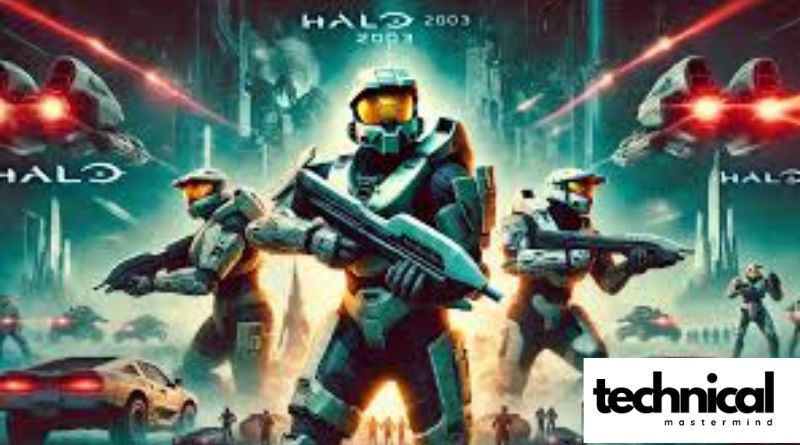Halo (2003) Game Icons Banners: A Legacy of Visual Excellence
The “Halo” franchise has become a cornerstone of the gaming industry since its inception, particularly with the release of “Halo: Combat Evolved” in 2001 and its sequel, “Halo 2,” in 2004. However, it was “Halo 3” in 2007 that further solidified the series’ reputation for quality and innovation. One of the most striking aspects of the “Halo” series is its visual presentation, particularly the game icons and banners associated with it. These elements not only serve practical purposes in-game but also contribute significantly to the franchise’s branding and identity. In this article, we will explore the evolution and significance of “Halo (2003) game icons banners,” examining how they reflect the series’ artistic vision and their impact on the gaming community.
The Evolution of Halo’s Visual Identity
From its early days, “Halo” has been characterized by its distinctive visual style. The original “Halo: Combat Evolved” introduced players to a rich, sci-fi universe filled with compelling characters and intricate settings. The game’s cover art, icons, and promotional banners established a brand identity that resonated with players and set a high standard for future titles.
The visual elements in “Halo” are not merely decorative; they embody the essence of the game. The icons, which players encounter on the dashboard and in menus, serve as a gateway to the game’s narrative and gameplay mechanics. These icons evolved over time, becoming more intricate and reflective of the evolving storyline. For instance, the transition from “Halo: Combat Evolved” to “Halo 2” marked a significant shift in design philosophy, as the developers sought to enhance the franchise’s visual storytelling capabilities.
The Significance of Icons and Banners in Gaming
In the context of gaming, icons and banners play a crucial role in user experience. They serve as visual cues that guide players through the game’s interface, providing immediate recognition of important features and functions. “Halo (2003) game icons banners” exemplify this principle by effectively conveying information and enhancing player engagement.
The design of these icons is influenced by several factors, including the game’s theme, mechanics, and narrative. In “Halo,” the icons often feature stylized representations of weapons, vehicles, and characters that are instantly recognizable to fans. This familiarity fosters a deeper connection between the player and the game, making the experience more immersive. Additionally, the banners that accompany promotional materials and in-game displays often showcase the game’s artwork and character designs, further enriching the player’s understanding of the game’s world.
Artistic Inspiration Behind Halo’s Visual Elements
The artistic inspiration behind “Halo (2003) game icons banners” draws from various sources, including military sci-fi aesthetics, classic space operas, and contemporary art movements. The game’s creators sought to craft a visual language that resonates with players on multiple levels, combining realism with stylized elements to create a unique and memorable aesthetic.
For example, the use of bold colors and striking contrasts in the game’s artwork highlights the tension and drama of the narrative. The icons, often designed with clean lines and vibrant palettes, capture the essence of each character or object they represent. The banners further enhance this visual identity, often incorporating dynamic poses and action-oriented compositions that convey the excitement of the gameplay.
Moreover, the collaboration between artists, designers, and storytellers during the development process ensures that the visual elements align with the game’s themes. The iconic Spartan armor, the imposing Covenant ships, and the serene yet dangerous landscapes of Halo’s rings all contribute to a cohesive visual narrative that players can easily recognize and appreciate.
The Impact of Halo’s Icons and Banners on the Gaming Community
The influence of “Halo (2003) game icons banners” extends beyond mere aesthetics. They have become symbols of a larger cultural phenomenon within the gaming community. Fans of the franchise often express their love for the series through fan art, merchandise, and community events, all of which celebrate the iconic imagery associated with “Halo.”
Social media platforms and gaming forums are filled with discussions about the meaning behind specific icons and banners, highlighting their significance within the broader context of the “Halo” universe. This engagement not only fosters a sense of community among players but also encourages new players to explore the series and its rich lore. The emotional connection that players form with these visual elements further cements their status as cultural artifacts in the gaming world.
The Role of Technology in Icon and Banner Design
The design of “Halo (2003) game icons banners” has also been shaped by advancements in technology. As graphics capabilities have evolved, so too have the possibilities for creating intricate and visually stunning icons and banners. The transition from 2D to 3D design allowed artists to experiment with depth, lighting, and texture, resulting in icons that are not only functional but also visually striking.
The introduction of high-definition graphics in subsequent “Halo” titles has enabled developers to create more detailed and lifelike representations of characters and environments. This technological evolution has had a profound impact on how players perceive and interact with the game. The icons and banners that accompany each title now reflect a level of artistry and craftsmanship that elevates the gaming experience.
Additionally, the integration of digital platforms has provided a new canvas for showcasing these visual elements. From official websites to social media campaigns, “Halo” has leveraged digital media to reach a broader audience. The use of animated banners and interactive icons allows players to engage with the content in new and exciting ways, further enhancing their connection to the franchise.
Conclusion: A Lasting Legacy
In conclusion, “Halo (2003) game icons banners” represent more than just graphical elements within a video game; they embody the artistic vision, technological advancements, and cultural significance of the “Halo” franchise. As the series continues to evolve, these icons and banners will remain integral to its identity, serving as a visual shorthand for the epic battles, compelling narratives, and rich universe that have captivated millions of players around the world.
Read also: check














Post Comment